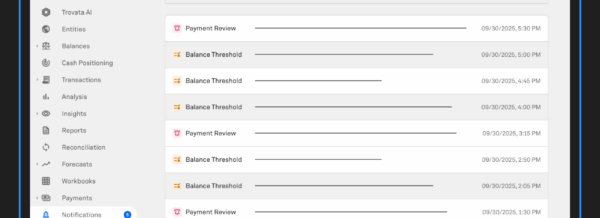It’s been a rollercoaster few weeks for the markets. With stocks plummeting and recession fears on the rise, it feels like we’re back in the thick of it. The latest jobs report only added fuel to the fire, leaving businesses and investors wondering what comes next.
While the stock market is beginning to steady after a volatile week, recession fears still loom large across the US. Everyone’s looking to the Federal Reserve for a lifeline, hoping for an emergency rate cut to calm the waters. But with the Fed meeting in September, it’s a long wait for potential relief.
Needless to say, for treasurers, there’s a lot of risk right now creating a need to fortify treasury resilience. The markets are all over the place, and it’s hard to know what’s around the corner. So, how do you keep your organization’s cash flow healthy? In a recent blog post we covered key areas treasurers should focus on to navigate the uncertainty ahead. Digital transformation is essential to build an agile and resilient treasury team that can adapt to the dynamic nature of the current market.
In this blog post, we’ll explore the exact technology you need to drive digital transformation that will have a measurable impact on your team’s efficiency and capabilities.

Building Treasury Resilience: The Role of Technology
To thrive in the current economic environment, treasury teams must embrace technology as a strategic asset. By leveraging advanced tools and platforms, treasurers can enhance their ability to manage risk, optimize cash flow, and make data-driven decisions.
The cornerstone of a resilient treasury function is a robust technology infrastructure. This includes systems and tools that can efficiently collect, process, and analyze financial data. Advanced analytics capabilities are essential for identifying trends, patterns, and anomalies that may impact the business.
However, many treasurers continue to grapple with the limitations of traditional, manual processes. Manually logging into multiple bank portals to pull reports, is time-consuming, error-prone, and hinders timely decision-making. Normalizing data in spreadsheets is a laborious task that leaves ample room for human error.
Treasury teams that leverage legacy treasury management systems (TMS) still struggle with limited functionality. This is often due to the platform being too complex, clunky, and falling short in delivering the granular data insights required for today’s strategic treasury role.
Modern treasurers need to be able to do deep bank data drill-downs, essential for identifying hidden opportunities, mitigating risks, and optimizing working capital. You need access to real-time, accurate, and comprehensive data to effectively support the evolving needs of the business. By automating data collection, standardizing formats, and providing advanced analytics capabilities, modern treasury platforms can empower teams to make more informed decisions and drive business growth.
Demystifying Modern Tech and Identifying Business Use Cases
Automated Bank Data Aggregation
Manually collecting and consolidating bank data is a time-consuming and error-prone process that can hinder a treasury team’s ability to make timely decisions. This is where automated bank data aggregation, powered by APIs, becomes invaluable.

What are Bank APIs?
Bank APIs are essentially digital bridges that enable secure communication between a bank and external applications. Think of them as translators that allow different software systems to understand and exchange financial information. Instead of manually transferring data, APIs automate the process, making it faster, more accurate, and efficient.
For treasurers, APIs act as digital bridges between your treasury system and your banks. Instead of manually logging into multiple bank portals to download statements, APIs allow your treasury platform to directly connect with your banks and automatically fetch the data you need. This eliminates manual data entry, reduces the risk of human error, and ensures data consistency.
While many treasury tech providers currently offer API connectivity, be wary of those that simply convert API data into legacy file formats and discard the additional transaction data APIs provide. Namely, legacy TMS providers, that have been around for decades, simply do not have the modern cloud-native infrastructure that enables a platform to ingest the more comprehensive data API connectivity provides.
The Benefits of Automated Data Aggregation for Treasury
For treasurers, the benefits of true end-to-end API bank connectivity are substantial. By automating data aggregation, you free up valuable time that can be spent on strategic initiatives, such as cash forecasting, risk management, and investment analysis. Additionally, real-time access to accurate bank data empowers you to make informed decisions quickly, such as optimizing cash positions, managing liquidity, and identifying potential fraud.
Furthermore, API-based data aggregation facilitates efficient reconciliation processes, improves the accuracy of financial reporting, and enhances compliance efforts. With a unified view of your bank accounts, you can streamline operations, reduce costs, and mitigate risks. Once you’ve automized the data aggregation process, you need to be able to organize and manage all of your bank data. That’s where leveraging a modern treasury platform with tagging capabilities provides unprecedented value.
Recommended: Check out our recent episode of Fintech Corner, as we chat with McKenzie Knudson, Senior Treasury Analyst at Sealaska, about her team’s transition from spreadsheets to the almost magical experience of API-based treasury tech, and how it helped to centralize data, streamline reporting, and foster collaboration.
Data Tagging and Organization: Unlocking the Power of Information
Effective data management is the cornerstone of a successful treasury function. By implementing a robust tagging system, treasury teams can transform raw data into actionable insights. Imagine having a comprehensive, organized library of financial information at your fingertips. That’s the power of data tagging.
By assigning specific tags or labels to transactions, payments, and other financial data points, treasurers can create a structured framework for analysis and reporting. This granular level of categorization enables deep dives into the data, uncovering hidden patterns, trends, and anomalies that might otherwise go unnoticed.

For example, tagging payments by supplier, category, and currency allows for detailed analysis of spending patterns, identifying cost-saving opportunities and potential risks. Similarly, tagging transactions by business unit, project, or department facilitates performance tracking and resource allocation decisions.
A well-structured tagging system is essential for generating accurate and informative reports. By filtering data based on specific tags, treasury teams can create customized reports that meet the needs of various stakeholders. Whether it’s analyzing cash flow, evaluating investment performance, or assessing financial risk, effective data tagging provides the foundation for data-driven decision-making.
Advanced Search Capabilities Enables Data-Driven Insights
In the current economic environment, stakeholders demand timely and accurate financial information. Treasurers are often called upon to provide insights into specific transactions, payment patterns, or financial performance. Advanced search capabilities are essential for meeting these demands efficiently.
A robust search function empowers treasury teams to quickly locate and analyze relevant data, transforming raw information into actionable insights. By being equipped to filter, sort, and refine transaction search results based on various criteria, you’ll be able to do deep data drill downs that facilitate in-depth analysis.

For example, treasurers can identify specific payments made to a particular supplier in a particular region, analyze foreign exchange transaction history, or uncover discrepancies in expense reports. This level of data exploration is crucial for scenario planning, forecasting, mitigating risks, and optimizing cash flow.
The Use Case for AI-Powered Automation in Treasury
While all of these tools provide unprecedented, game-changing benefits for treasurers. It all needs to be automated to be truly impactful for treasurers. This is where AI and Machine Learning (ML) provide value in treasury operations.
AI and ML can streamline the report generation process by automating data collection, calculations, and formatting. By leveraging a modern treasury platform with true end-to-end API bank connectivity, you can create reports that are not only accurate but also update in real-time. By combining AI with bank APIs, modern treasury platforms empower treasurers to create dynamic reports that automatically refresh as bank data changes, providing a continuous stream of up-to-date financial insights.

Cash forecasting is another area where AI can significantly enhance efficiency and accuracy. By analyzing historical data, AI algorithms can generate predictive models that forecast future cash flows with greater precision. This empowers treasurers to optimize cash positions, manage liquidity risks, and make informed investment decisions.

Furthermore, AI can be employed to automate the tagging process, improving data organization and accessibility. Machine learning algorithms can analyze transaction data and automatically assign appropriate tags, saving time and reducing errors. This enriched data can then be leveraged for advanced analytics and reporting.
Trovata: Your Partner in Treasury Transformation
Trovata is a treasury platform designed to help organizations navigate the complexities of modern finance. With its focus on automation, data aggregation, and advanced analytics, Trovata empowers treasury teams to make informed decisions, mitigate risks, and optimize cash flow.
Unparalleled Bank Connectivity: Trovata built the world’s largest library of corporate banking APIs for multi-bank connectivity as a managed service with direct access to 50+ of the largest financial institutions in the world, along with access to 2000+ more via sFTP and SWIFT.
Robust Tagging and Reporting: With Trovata’s flexible tagging system, treasurers can create customized reports and dashboards for more comprehensive business intelligence.
Powerful Search and Analytics: Trovata’s advanced search capabilities enable deep data exploration, allowing treasurers to uncover hidden insights and make data-driven decisions.
Open API Architecture: Trovata’s API-first approach facilitates seamless integration with other financial systems, creating a unified treasury ecosystem.
Unlimited Data, High-Speed Processing: Trovata is the only leading treasury solution natively built for the cloud. This enables limitless data storage and ensures smooth performance even with massive datasets. Whether you’re an emerging company or a large global enterprise, Trovata grows with you.
Fast Implementation With No IT Support Required: Our modern tech infrastructure simplifies implementation. That means you can get started in weeks, not months, with no IT support needed.

By partnering with Trovata, treasury teams can enhance their resilience, improve operational efficiency, and drive business growth. In today’s dynamic market environment, a robust treasury function is essential for organizational success. To learn more, schedule a demo today!




